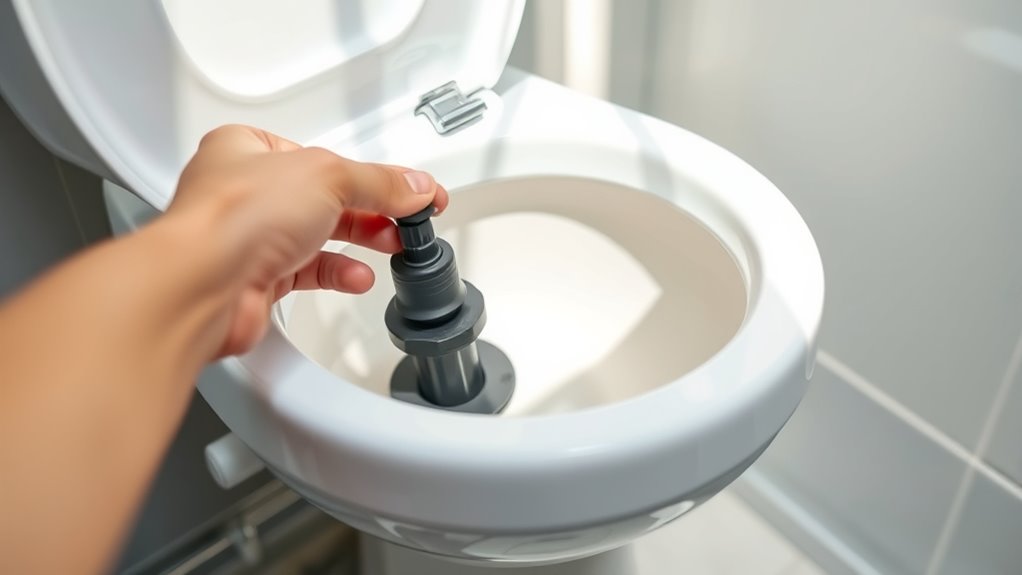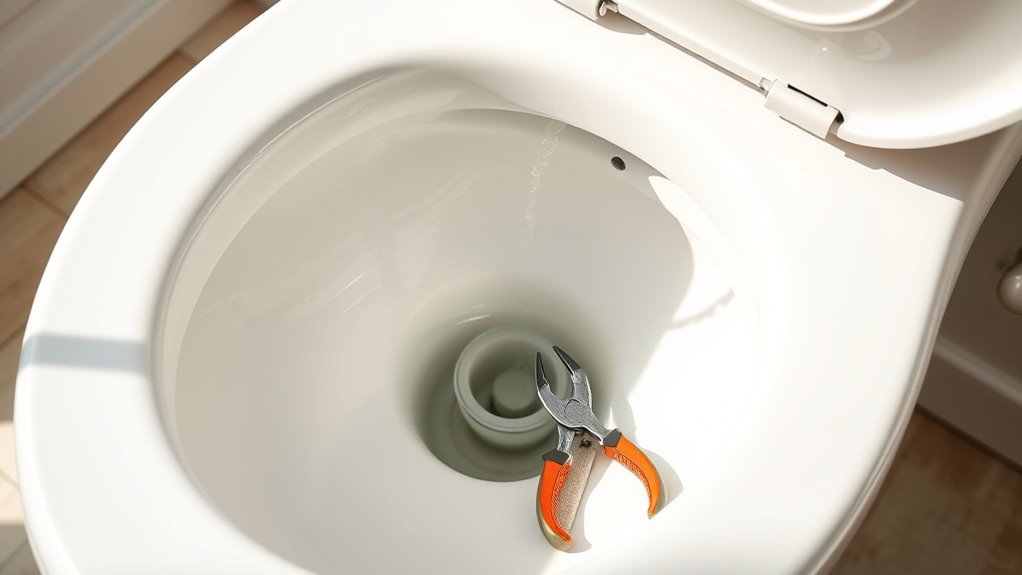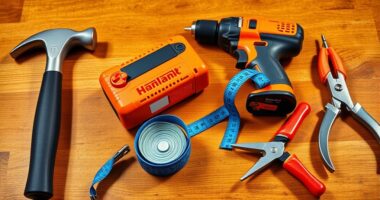To fix a running toilet, first turn off the water supply behind the tank and flush to drain it. Inspect the fill valve and replace it if it’s damaged or faulty. Check the flapper for wear or debris, and replace it if needed. Clean sediment buildup inside the tank and adjust the float to the correct level. If you follow these steps carefully, you’ll prevent continuous running and keep your toilet working efficiently. If you continue moving forward, you’ll find even more helpful tips.
Key Takeaways
- Turn off the water supply and drain the tank by flushing before inspecting components.
- Check and replace faulty fill valves or damaged flappers to stop continuous water flow.
- Clean mineral buildup and debris from the fill valve, flapper, and inside tank components.
- Adjust the float or internal parts to ensure proper water level and prevent running.
- Reassemble, turn the water back on, and observe the tank for proper filling and flushing.

A constantly running toilet can waste a lot of water and increase your utility bills, but fixing it is often simpler than you might think. The most common cause is a malfunction within the tank, which affects how the flushing mechanism works. To start, you should check the valve and consider a valve replacement if it’s faulty. The fill valve controls the water level in the tank, and if it’s not functioning properly, the water keeps running. First, turn off the water supply to the toilet, usually by twisting the valve located behind the tank. Flush the toilet to drain most of the water, then remove the lid from the tank. Inspect the fill valve for signs of damage or wear. If it looks old or corroded, replacing it can resolve the issue. You can find replacement fill valves at any hardware store, and they usually come with instructions. Installing a new valve often involves disconnecting the old one, attaching the new valve in its place, and adjusting the height to ensure the water level stops at the correct mark. Once installed, turn the water back on, and check if the tank fills to the proper level without continuously running.
Another common cause of a running toilet is debris or mineral buildup inside the tank, which can interfere with parts like the flapper or float. Performing tank cleaning can often fix these issues. Turn off the water supply and drain the tank by flushing. Remove any buildup on the flapper, which is the rubber seal at the bottom of the tank that controls water flow into the bowl. If the flapper is damaged or warped, replacing it is a quick fix. While you’re in there, clean the inside of the tank, removing sediment or mineral deposits that could be affecting the functioning of the fill valve and other components. Use a brush and some mild cleaning solution or vinegar to scrub away buildup. After cleaning, reassemble everything, turn the water supply back on, and observe the tank filling and flushing. If the toilet continues to run despite these efforts, you might need to adjust the float or replace other internal parts.
Regular maintenance, including inspecting the toilet components, can prevent future problems and improve efficiency. Addressing these common issues—valve replacement and tank cleaning—can restore your toilet’s proper function and save you money on water bills. Most repairs are straightforward, and with a few basic tools and some patience, you can fix a running toilet yourself without needing a plumber.
Frequently Asked Questions
Can a Running Toilet Increase My Water Bill Significantly?
A running toilet can definitely increase your water bill considerably. It wastes water constantly, making it harder to practice water conservation. Regular plumbing maintenance, like fixing leaks, can prevent this issue. By addressing a running toilet promptly, you save money and help conserve water. Don’t ignore the signs of a leak—taking quick action ensures your water bill stays manageable and your plumbing stays in good shape.
How Often Should I Check My Toilet for Leaks?
If you ignore your toilet’s leak detection, you could flood your bathroom with water faster than Niagara Falls! You should check your toilet for leaks at least once a month as part of your routine maintenance schedule. Regular inspections help catch tiny issues early, saving you from costly repairs and sky-high water bills. Don’t wait until a leak turns your bathroom into a swimming pool—stay vigilant and keep your toilet in top shape!
Are There Any DIY Methods to Prevent a Running Toilet?
You can prevent a running toilet with simple DIY methods. Start by checking the flapper adjustment, ensuring it seals properly after each flush. Also, inspect the float valve; if it’s set too high, water will keep running. Adjust these components gently, and you’ll stop the water from constantly flowing. Regularly checking these parts helps maintain your toilet’s efficiency and prevents future issues without needing professional help.
What Tools Are Necessary to Fix a Running Toilet?
To fix a running toilet, you’ll need a few basic tools. Start with a toilet flapper, which often causes the issue, and an adjustable wrench to loosen and tighten nuts. You might also need a screwdriver and pliers for additional parts. These tools make it easier to replace or adjust the flapper and other components, helping you stop the water from running and save on your water bill.
When Should I Call a Professional Plumber Instead of Fixing It Myself?
They say, “A stitch in time saves nine,” so knowing when to call a professional is key. If you’re facing plumbing emergencies or complex repairs, don’t push your luck—these issues can worsen or cause damage. When you feel unsure, lack the right tools, or the problem persists after basic fixes, it’s best to contact a plumber. They’ll guarantee your toilet’s fixed right the first time, saving you hassle and expense.
Conclusion
With a little patience, you can quiet that relentless trickle, restoring calm to your bathroom. Imagine the peaceful silence replacing the constant drip, like rain tapering off into a still pond. Fixing your running toilet not only saves water but also brings a satisfying sense of accomplishment. Soon, every flush will be smooth and silent, leaving your bathroom feeling fresh and serene. Just a few simple tweaks, and you’ll enjoy the soothing sound of stillness once again.









